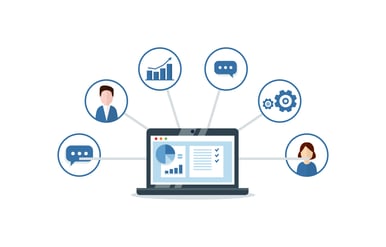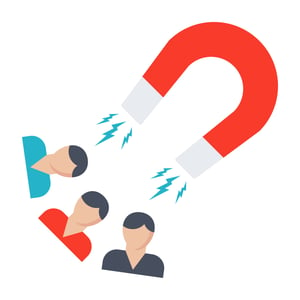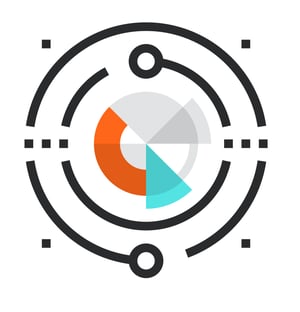
Top-of-funnel is the first step in the customer journey. If you don't get their attention here, it will be challenging to get it later. So, how do you ensure the work you're doing is creating the qualified leads you need from your top-of-funnel content strategy? One word: data.
 Why Track Your Marketing Efforts?
Why Track Your Marketing Efforts?
2020 brought significant changes to just about every aspect of our lives. Consumer adoption of eCommerce and home delivery saw unprecedented growth. Customers formed new habits. Three-quarters of consumers tried new shopping behaviors, and 73% said they'd continue to buy this way.
Most B2B seller interactions have now moved to remote and digital as well. Bigger deals than ever are getting done in a digital environment. 27% of B2B purchasing over $500k occurred online or remotely.
If you're wondering why you should track your marketing efforts, it's because buyer behavior has changed dramatically. You need the right information from various data sources to make informed decisions about the best way forward. Saying it's no longer business as usual is a gross understatement.
Pro Tip: 👍
Tracking your marketing efforts give you a way to measure performance. It provides both transparency and accountability. It defines whether your efforts are successful, whether you need to tweak performance, or whether you need to adopt new strategies.
Understanding the Customer Journey
Customers used to talk with salespeople to gather information and make decisions. Now, they're searching online. The majority of purchase decisions happen before customers ever speak to a salesperson – whether it's a B2C shopper or a B2B buyer.
The sales funnel we all grew up with has been around since 1898. The customer journey has changed a bit since then. That's why many of today's top marketers are using a flywheel approach to the customer journey.
James Watt invented the flywheel more than 200 years ago as part of the industrial revolution. In steam engines, the flywheel was highly efficient at capturing, storing, and releasing energy. The more force you apply, the faster it spins. The less friction it faces, the faster it spins.
Your marketing can work the same way. Rather than thinking just about outcomes, it's essential to think about how you can build momentum with buyers and keep your business spinning. The flywheel concept manages the entire eco-cycle of the customer journey and breaks it down into three segments of the wheel: Attract, Engage, Delight.
 Attract
Attract
The "Attraction Stage" is where top-of-funnel content is most effective. Your content strategy provides useful content that earns the attention of prospects.
The more force you apply – content optimization, SEO, paid marketing, social selling, etc. – the better it performs. Reducing friction by making it easy to find, read, and engage makes the flywheel spin faster.
 Engage
Engage
By reaching customers on their preferred channels and customizing content to buyer needs, you get the wheel turning even faster. Force might include email personalization, marketing segmentation, sales automation, lead scoring, and lead nurturing.
Reducing friction includes making it easy for customers to buy. This "ease" might provide the information they need to make informed purchases, free demos, and multiple communication channels.
 Delight
Delight
In the final section, you delight customers by helping and support them to reach their goals. Forces might include self-service tools, proactive customer services, and follow-ups.
Delighting customers keeps the flywheel spinning. Happy customers are more likely to buy more often and spend more. They're also more likely to share positive experiences, provide referrals, and apply more force to the flywheel.
 What Top-of-Funnel Content Should Look Like
What Top-of-Funnel Content Should Look Like
Before you can get that flywheel spinning, you've got to attract their attention. Top-of-funnel content comes designed to do just that.
Think of it as the discovery stage. It's where customers first learn about your company, products, or services. Because they're just beginning the customer journey, they're likely not yet at the buying stage. That means you've got to educate them before you sell them.
SEMRush surveyed marketers about which top-of-funnel content performs the best. Here's what they had to say.
- 72% How-to Guides
- 35% Landing Pages
- 28% Infographics
- 27% Checklists
- 26% eBooks and White Papers
Missing from this list are some of the tactics designed to get people to find top-of-funnel content in the first place, such as paid marketing and SEO strategies.
Pro Tip: 👍
Learn more about what content for middle-of-funnel audiences should look like by reading our companion article.
 Data Worth Tracking
Data Worth Tracking
Of course, the most important thing to track is whether you're reaching your overall goal. If that's not happening, other metrics don't matter. As we know, however, there's a cause-and-effect aspect to digital marketing. If your goal is conversions, it won't happen if people aren't seeing or engaging with your content.
Besides your overall goal, you'll want to track the KPIs that contribute. If you're missing the mark with your overall goal, often the answer lies in the other KPIs you're following. These options can include metrics such as:
- Blog views
- Video views (YouTube, Instagram, Facebook)
- Podcast downloads and listening
- Paid Marketing (Impressions, Reach, Clicks, Leads, Video Views)
- Social shares
You'll also want to get granular with the data. For example, beyond views of blog content, you'll want to know how long visitors engaged with it and what actions – if any – they took after engaging. Do they fill out a form, click on a link, read more content, or just leave? These insights can help you gauge the effectiveness of your content. The same strategy applied to videos or podcasts.
Pro Tip: 👍
You need to pay particular attention to any of your paid marketing. Optimizing content, channels, budgets, bids, keywords, and landing pages can make everything work more efficiently. Marketers should always be A/B testing at each stage for continuous performance improvement.
 Make Data Reporting a Priority This Year
Make Data Reporting a Priority This Year
When flywheels are spinning smoothly, it produces the kind of energy it takes to power steam engines. It's not that easy, however. Starter drive components can wear out. Gravel can get in the flywheel and cause friction. It can throw off excessive heat and wear down the metal. It takes a consistent approach to monitor and measure performance to keep things running smoothly.
The same philosophy applies to your content strategy and marketing. If you've got the wrong components (data sources, marketing channels, content), it's not going to run smoothly. If customer behavior changes, you may need to evolve your strategy. If things are wearing out or no longer working efficiently, you've got to make changes.
Finding these things out before they become significant issues is always preferable. It would be best if you were vigilant about measuring, monitoring, and optimizing to get the best results. In 2021, make data reporting a priority to make the best data-driven decisions.




.gif?length=600&name=Data%20Bottom%20of%20funnel%20hero%20(1).gif)


No Comments Yet
Let us know what you think